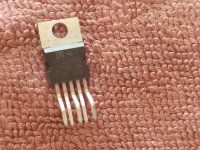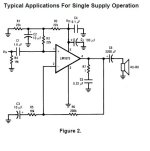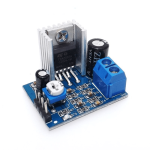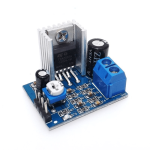That silicon being different is simply a made up story.
Different quality of silicon is indeed used for different applications, a CPU will have a much purer and closely inspected grade than a chip amp.
But within the same class, I do not expect much variation.
Here in India, I am able to get Taiwan made as well as three different Chinese brands of 2030, the Taiwan one seems to be a licensed copy, marking is TDA2030A.
There is a triangle marked one made by CRC China, another no brand quality, and a "ST" marked quality, which works at above voltages....the triangle marked chips are in the 20 US cents price in retail, TI chip is above $3 in small quantities from Mouser etc.
Normal quanity is 50,000 per shipment ex factory, so yes, they are made in milions of units annually.
Different quality of silicon is indeed used for different applications, a CPU will have a much purer and closely inspected grade than a chip amp.
But within the same class, I do not expect much variation.
Here in India, I am able to get Taiwan made as well as three different Chinese brands of 2030, the Taiwan one seems to be a licensed copy, marking is TDA2030A.
There is a triangle marked one made by CRC China, another no brand quality, and a "ST" marked quality, which works at above voltages....the triangle marked chips are in the 20 US cents price in retail, TI chip is above $3 in small quantities from Mouser etc.
Normal quanity is 50,000 per shipment ex factory, so yes, they are made in milions of units annually.
It is necessary to take into account the limited capabilities of current, voltage and power dissipation (in accordance with the datasheet)))Using a chip amplifier,
It seems to me after reading the thread again, that the OP wants to repair or modify a set of Philips active speakers with a +/- 30V supply.
There are many Class D and Class AB plate amplifiers available, if supply and drivers are good, for that voltage rating.
Or else, put a matching power supply for whatever plate amp you choose, I get them for what will seem a prank price to you.
That is easier and faster than a quest for chips at max. rating, no point in stressing the parts.
A 3A 12-0-12 transformer will be around $5 here, and a plate amp with bass, treble and balance points on the PCB, based on either 4440 or 2030 class chips will be $3 or so, hook up and use...after mounting and wiring, of course.
There are many Class D and Class AB plate amplifiers available, if supply and drivers are good, for that voltage rating.
Or else, put a matching power supply for whatever plate amp you choose, I get them for what will seem a prank price to you.
That is easier and faster than a quest for chips at max. rating, no point in stressing the parts.
A 3A 12-0-12 transformer will be around $5 here, and a plate amp with bass, treble and balance points on the PCB, based on either 4440 or 2030 class chips will be $3 or so, hook up and use...after mounting and wiring, of course.
If I really get one made to order, it is like $10 to 12, copper and steel prices have gone up. E-I, not toroid in design.
There is a small workshop here, making and repairing transformers and coils. He uses proper wire and cores.
That price in previous post is for a Delhi made unit.
It is really more in the 1.5A continuous load class, in a use like audio for a stereo chip amp that is enough.
The Delhi area has thousands of electronics manufacturers, ranging from tiny to humongous.
Quality, you get what you are willing to pay for...
Price wise, the high labor costs in your area, and the low volumes may make things expensive, here I can ask how many kilos / grams of wire and steel were used!
So I can work out if he gave me a proper unit, at a fair price.
I trust him, using his parts since many years...so really just for my knowledge.
There is a small workshop here, making and repairing transformers and coils. He uses proper wire and cores.
That price in previous post is for a Delhi made unit.
It is really more in the 1.5A continuous load class, in a use like audio for a stereo chip amp that is enough.
The Delhi area has thousands of electronics manufacturers, ranging from tiny to humongous.
Quality, you get what you are willing to pay for...
Price wise, the high labor costs in your area, and the low volumes may make things expensive, here I can ask how many kilos / grams of wire and steel were used!
So I can work out if he gave me a proper unit, at a fair price.
I trust him, using his parts since many years...so really just for my knowledge.
H
HAYK
I bought Chinese LM1875/TDA2050 with 3 different labels, inside they are the same rectangular chip. It is unity gain stable, temperature protection 85°C but no short circuit or current limiter. It has more bass than LM3886 or TDA7294 using the same supply +/-27v max. It has higher drop out than 2050 but lower than the LM1875. The sound has a particular high frequency grain that many Asians, Russians and those who appreciate fine female voices love such sound as it make the voice, golden. It seams, they TDA2050 with a triangular shape logo has high OLG rendering slightly drier bass and more pronounced high frequencies for extra cost.
What I don't understand, why the OP doesn't buy a TDA7294 amplifier board for $4 as,
https://aliexpress.com/item/1005005753876111.html
https://aliexpress.com/item/1005005753876111.html
Attachments
There is a reason most Electronics Manufacturing has moved to Asia: good productivity, good quality, low-ish wages, ample and cheap materials sourcing ... an unbeatable combination.3A 12 0 12 for 5$?
You are lucky, very lucky!
LM1875 bought from local dealer price 8 €. Pictures before and after. Board from AliExpress changed to single power. Last picture + 60 Volts pin burned. 😡


Wrong way, I speak using single power supply. Data books say; max is 60 Volts.Look at the data sheet for safe voltage ratings, stay within typical rather than max. ratings...+/- 25V for 1875.
I would play safe and go about +/- 20V, that would still give a decent power output.
If you go higher, you will go near the danger zone, close to the limits of the device.
And way too loud for most users.
Reading manufactures databooks.Where did you get that info from?
LM1875 is available at most of the trusted retailers + ti.com, so you have no excuse for buying from AliExpress.
The spec sheet for 1875 says typical +/- 25V, or 50V single supply.
That is the real world practical value to be used in working designs, the higher value is the never exceed value, as a limit if something like a high voltage spike happens.
So you are taking the part to above the practical limits.
And then you are complaining it burns!
But why are you stuck on 1875?
There are other amplifier circuits, and I have given suggestions for alternates.
You paid 8 Euros?
Here the TI chip is about $3, from Mouser IIRC...
That is the real world practical value to be used in working designs, the higher value is the never exceed value, as a limit if something like a high voltage spike happens.
So you are taking the part to above the practical limits.
And then you are complaining it burns!
But why are you stuck on 1875?
There are other amplifier circuits, and I have given suggestions for alternates.
You paid 8 Euros?
Here the TI chip is about $3, from Mouser IIRC...
Last edited:
But why are you stuck on 1875?The spec sheet for 1875 says typical +/- 25V, or 50V single supply.
That is the real world practical value to be used in working designs, the higher value is the never exceed value, as a limit if something like a high voltage spike happens.
So you are taking the part to above the practical limits.
And then you are complaining it burns!
But why are you stuck on 1875?
There are other amplifier circuits, and I have given suggestions for alternates.
You paid 8 Euros?
Here the TI chip is about $3, from Mouser IIRC...
Because:
I try to put LM1875 instead
to philips MFB_ Speaker_22rh532 to drive middle and high speaker, system works with single supply 57 volts.
I dont put more power supplys into active speaker box. In stuck I am, because hard to find working audio amplifier, which last 60 Volts.
Attachments
Last edited:
I have an observation. If irrelevant, just ignore it. The 1875 singleton outputs a vicious surge through the speaker when power is applied. I think there is a race condition on the input pins which can be mitigated by increasing C3 to about 200uf. Otherwise, feed the speaker through a resistor which has a bypass switch. Procedure: open the switch for a few seconds while power is applied. The speaker cap will be partially charged when the switch is closed. This will reduce or eliminate the thump.
Thanks for posting.But why are you stuck on 1875?
Because:
I try to put LM1875 instead

to philips MFB_ Speaker_22rh532 to drive middle and high speaker, system works with single supply 57 volts.
I dont put more power supplys into active speaker box. In stuck I am, because hard to find working audio amplifier, which last 60 Volts.
Just thinking aloud and trying to help.
1) even buying locally instead of straight from AliExpress does NOT guarantee you got a real 1875 🙁 because you don't know where HE got them from.
He may be a good faith buyer or seller but HIS supplier may deal in rotten goods.
Unless he bought straight from TI or Mouser ... no guarantees.
I was burnt by TDA2050 bought from a local "respected seller", go figure.
They are visually perfect.
How do I know they are fake? (or substandard/factory rejects/whatever)
Because they burn with supposedly acceptable supplies.
Same as yours.
2) voltage is not the only parameter.
You are trying to replace one "60V" with another "60V" one?
Ok, BUT:
besides it being fake or not, original Philips uses two TO220 packages while now you use only one.
Dissipation can not be the same.
Now LM3886 case is exactly two TO220 side by side.
I can trust that
About current:
1875 can supply 4 A peak ... period.
Original Darlingtons can supply 8A continuously and 12A short term
Again 1875 falls WAY short compared to what originals can
Check 3886 datasheet, it must supply at least 6 to 8 A
Meaning: LM1875 is marginal at best, if not straight incapable, sorry, go for it's big brother 3886
3) and not sure about your AD5060 woofer, there is /W4 and /W8 versions
If it's W4 LM1875 will explode trying to drive it.
Even 3886 will be just enough.
4) can't you try to repair original woofer amp board?
It might be the safest way.
Oh, and you posted the mid/high section schematic; woofer must be different ... specially because it incorporates motional feedback.
Did you use a heat sink on the chips?
You can also modify the speakers to passive, take the amp outside, more choices in that case.
You can also modify the speakers to passive, take the amp outside, more choices in that case.
Rampo,
That lm1875 chip looks real to me,
I have a feeling that you made a mistake when you modified that board to work with a single voltage power supply.
Instead of using that board just try to wire connect the components according to the TEXAS Instruments datasheet
That lm1875 chip looks real to me,
I have a feeling that you made a mistake when you modified that board to work with a single voltage power supply.
Instead of using that board just try to wire connect the components according to the TEXAS Instruments datasheet
Last edited:
- Status
- Not open for further replies.
- Home
- Amplifiers
- Chip Amps
- Fake LM1875





